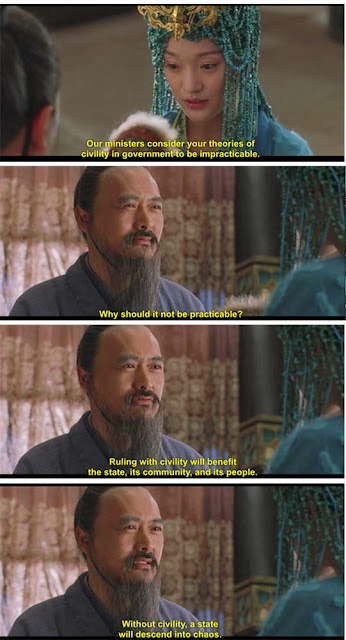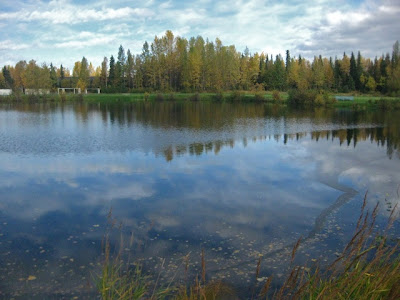Confucius consents to an audience with the royal consort of Wei against the wishes of his disciples. She has a reputation as a beautiful woman with a sketchy past and she clearly is intent on seducing the great scholar.
She starts off by asking about the Book of Odes, and the love poetry in it.
 |
| Screen shot from Confucius. (孔子 (Kong Zi) Director: Mei Hu) |
 |
| Screen shots from Confucius. (孔子 (Kong Zi) Director: Mei Hu) |
 |
| Screen shots from Confucius. (孔子 (Kong Zi) Director: Mei Hu) |
 |
| Screen shots from Confucius. (孔子 (Kong Zi) Director: Mei Hu) |
While there is much about Confucian teaching that is problematic today - particularly his rigid hierarchical power structure and his low regard for women - there is also much of use to our political leaders today.
I'd note that Thomas Jefferson, one of the inspirations of the Tea Party, was something of a China scholar. From a scholarly paper "Thomas Jefferson's Incorporating Positive Elements From Chinese Civilization" by Dave Wan.
(Note that the poem Jefferson clips out in the passage below, is the one referred to by the Royal Consort of Wei in the film - "The Book of Odes." The poem is a tribute to the Prince of Wei - several hundred years prior to Confucius.)
"Founding Inspiration from the Confucius’ ClassicsImportant themes that we should remember from Confucius is his emphasis on ethics, on education, on harmony and treating people with respect and taking care of the poor and less fortunate.
In the nineteenth century intellectuals in the United States often enjoyed creating personal scrapbooks, in which they would cut out their “favorite newspaper articles and poems” and past “them onto the backs of old letters to create a sort of personal literary anthology.” None of us will feel surprised to know that Thomas Jefferson, “an Enlightenment intellectual,” created a scrapbook in his own way. Some time from 1801-1809 Jefferson included in the section of his scrapbook titled Poems of the Nations an ancient Chinese poem from The Book of Odes. His love of the poem provides us with a window through which we can look into his efforts to learn from Chinese culture. What he wanted to learn from the poem?
Below is Jefferson’s clipping of the poem:
A Very Ancient Chinese Ode
Translated by John Collegins seq
Quoted in the To Hio of Confuciues
(….from a manuscript presented in the Bodlein Library )
SEE! how the silvery river glides,
And leaves' the fields bespangled sides !
Hear how the whispering breeze proceeds!
Harmonious through the verdant reeds!
Observe our prince thus lovely shine!
In him the meek-ey'd virtues join!
Just as a patient carver will, Hard ivory model by his skill,
So his example has impress'd Benevolence in every b[re]ast;
Nice hands to the rich gems, behold,
Impart the gloss of burnish'd gold:
Thus he, in manners, goodly great,
Refines the people of his state. True lenity,
how heavenly fair !
We see it while it threatens,—spare!
What beauties in its open face!
In its deportment—what a grace!
Observe our prince thus lovely shine!
In him the meek-ey'd virtues join!
His mern'ry of eternal prime,
Like truth, defies the power of time!
The poem pays tribute to Prince Wei from the State of Wei, who was loved, respected and remembered by the people of his state. Confucius (551-479 BC) highly praised Prince Wei, described in the poem, when he quoted this poem in his famous book, The Great Learning, to provide a standard to inspire other princes and leaders of various states to follow. Confucius said,
In the Book of Ode, ‘Ah! The former kings are not forgotten’ Future princes deem worthy what they deemed worthy, and love what they loved. The common people delighted in what they delighted them, and are benefited by their beneficial arrangements. It is on this account that the former kings, after they have quitted the world, are not forgotten."
Just something to think about on a cloudy Saturday.
____________________________
I don't particularly recommend this film as a film. But as an easy (and visually beautiful) overview of the life of Confucius it will do. It tends to give us a series of vignettes of his life, with very little character development. The two actors in these screenshots are (from Wikipedia):
- Chow Yun-fat as Confucius or Kong Qui, also known by the honorary title Zhong Ni.
- Zhou Xun as Nanzi, the royal consort of Wei.


















































